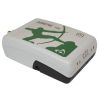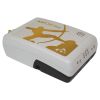Eos Bridge Bluetooth Connector
The Eos Bridge is a palm-sized Bluetooth connector that makes any third-party instrument Bluetooth compatible with iOS, Android or Windows devices.
Features
- Transforms legacy Bluetooth instruments into iOS-compatible devices
- Converts non-Bluetooth instruments into iOS-compatible devices via serial port
- Rechargeable Li-Ion battery using standard USB connection
- Free ground shipping
- Expedited repair and warranty service
- Lifetime technical support
- More
The Eos Bridge is a palm-sized Bluetooth connector that makes any third-party instrument or sensor, such as a laser rangefinder, Bluetooth compatible with iOS, Android or Windows devices. This allows you to combine the power of survey-grade mapping from Arrow Series GNSS receivers, GIS apps and professional measurements from third-party instruments and sensors.
Convenient, Portable and Rugged
With its long-lasting battery, the Eos Bridge delivers days of continuous use on a single charge. And thanks to its lightweight design, the Eos Bridge can easily be stored in a pocket, clipped to a belt, or attached directly to any instrument. The Eos Bridge is also rugged and waterproof, so you can confidently take it to the harshest environments.
Connect with Legacy-Bluetooth Instruments
Have you ever wished your existing laser rangefinder, utility locator — or any other sensor — would automatically send data to your mobile mapping solution? The days of wishing are over. With the Eos Bridge, simply pair any legacy instrument to your iOS device (while connected to an Arrow GNSS receiver), and the Eos Bridge takes care of the rest. Measurements from your professional instruments will flow directly to iOS, where you can capture them in a GIS app with high-accuracy locations from your Arrow GNSS receiver.
Connect with Serial Port
No legacy Bluetooth module? No problem. Instruments and sensors can also connect to the Eos Bridge via a serial port to achieve the same results. Choose this option to use the Eos Bridge with not only iOS devices, but also Android and Windows smartphones and tablets.
- Eos Bridge
- Integrated Li-Ion Battery
- USB Charger
- Belt Clip
- Strap Loop
In The News
From Paddles to Phytoplankton: Studying Vermont’s Wildest Lakes
For six months of the year, Rachel Cray, a third-year PhD student at the Vermont Limnology Laboratory at the University of Vermont, lives between a microscope and her laptop, running data. For the other six months, she is hiking and canoeing four of Vermont’s lakes, collecting bi-weekly water samples. Cray studies algal phenology across four lakes in Vermont, US, that have low anthropogenic stress—or in other words, are very remote. Funded by the National Science Foundation Career Award to Dr. Mindy Morales, the lakes Cray researches part of the Vermont Sentinel Lakes Program, which studies 13 lakes in the area and, in turn, feeds into the Regional Monitoring Network, which operates in the Northeast and Midwest US.
Read MoreReimagining Water Filtration: How Monitoring and Science Enhance FloWater Filtration Systems
Over 50% of Americans think their tap water is unsafe , according to the Environmental Working Group (EWG). Other recent surveys have found that number to be as high as 70% of persons surveyed. Whether due to increased public awareness of water quality issues or confusion about how municipal water sources are regulated, there is a clear distrust of tap water in the United States. According to industry expert Rich Razgaitis, CEO and co-founder of the water purification company FloWater, this issue creates a damaging cycle. Razgaitis explained that the health and environmental problems associated with contaminated water aren’t the only issues. As people become increasingly aware that some tap water is unsafe, they resort to bottled water.
Read MoreMonitoring New Hampshire’s Aquatic Ecosystems: Continuous Data Collection in the Lamprey River Watershed
New Hampshire’s aquatic ecosystems provide a range of ecosystem services to the state and region. Resources and services like clean water, carbon storage, climate regulation, nutrient regulation, and opportunities for recreation all depend on New Hampshire’s aquatic ecosystems remaining healthy. Jody Potter, an analytical instrumentation scientist at the University of New Hampshire (UNH), is studying these aquatic ecosystems in hopes of developing an improved understanding of ecosystem services and their interactions with climate change, climate variability, and land use changes. [caption id="attachment_39799" align="alignnone" width="940"] Aquatic sensors in the Merrimack River in Bedford, NH, with I-293 in the background.
Read More









